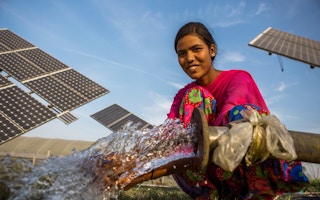Energy access plays a big role in a nation’s economy and security, which is why we see countries all around the globe urgently increasing their electrification rates. However, there is a significant gap between energy access in urban areas and rural areas.
Energy planning is centralised, which means that it is often focused on increasing supplies of fuel and electricity for industrial and urban uses. Meanwhile, rural energy needs for domestic, agricultural, and small-scale informal production activities are usually given low priority.
This urban-rural gap contributes to widening gender inequality as these small-scale industries are mostly headed by women. Of the 1.2 billion people living on the equivalent of US$1 a day, 70 per cent are women. In rural areas, women’s responsibilities traditionally include collecting fuel and water. Fewer women have stable jobs compared to men, which makes women more prone to poverty.
Currently, grid-based electrical power does not reach many rural and poor urban areas in developing countries, especially in Asean. Coupled with the inadequate distribution of cooking and heating fuels, many young girls are pushed to leave school to collect firewood for fuel.
Women and girls would benefit the most from access to improved energy services as it will lighten the load of their daily tasks to free up more time for other social and economic opportunities.
Success stories of gender-energy access programmes in Asean
There have been many initiatives to boost women’s participation in energy access programmes, but more needs to be done. In Indonesia, where more than 50 million people live without reliable access to electricity and more than 100 million people still cook over three-stone fires, the Wonder Women programme by ENERGIA and Kopernik has assisted more than 600 women to become micro-social-entrepreneurs.
The trained women sell technologies such as solar lights, water filters and clean cookstoves to more than 176,140 people in their community at as close to retail price as possible. This has allowed the women to earn a small margin on every sale, therefore boosting their income to support their families and themselves.
In addition, Asean, especially Indonesia, is abundant in biomass. This has led many non-governmental organisations (NGOs) to develop small-scale bioenergy projects that require a relatively small capital. The use of biogas was able to save the women more than one hour every day, providing them with more time to engage in social activities, entrepreneurship, and other income-generating opportunities.
Biogas also has other income-generating benefits through the sale of bio-slurry as organic fertilisers. According to a 2014 IDBP final report, five per cent of biogas users, including women, were able to improve their incomes between Rp 20,000 to Rp 600,000 every month through this process.
One of the most influential gender-energy access organisations in Indonesia is the Institut Bisnis dan Ekonomi Kreatif (IBEKA). IBEKA works with UN-ESCAP to provide rural communities with access to sustainable energy solutions within the 5P (Pro-Poor Public Private Partnership) initiative. Currently, IBEKA is running 88 energy access programmes all over Indonesia, namely by installing micro-hydropower projects, solar PV systems and wind turbines.
In Vietnam, the Green Innovation and Development Center (GreenID) has launched several rural electrification projects all over Vietnam. Partnering with the European Union and the United Nations Development Programme, GreenID’s rooftop solar power project has helped improve the income of local communities and ensure energy security while also promoting sustainable development.
In Myanmar, Groupe Energies Renouvelables, Environnement et Solidarités (GERES) has partnered with Agence Française de Développement (AFD) in training more than eight women in business to promote and sell Sustainable Energy Solutions (SES) such as solar lamps and kits, as well as an improved wood cook-stove. This has allowed women in the most remote villages to safely charge their phones, enabling them to work in the evenings.
GERES has also initiated gender-energy access programs in Cambodia through facilitating community access to biomass energy and improved cookstoves that consume less fuel. As part of their process, GERES considers the local culture of rural communities by hiring traditional pottery producers and distributors to disseminate the new and improved products. This has resulted in 3,000 jobs created as producers, distributors, and retail sellers, 52 per cent of which went to women.
The case studies affirm that small-scale, decentralised energy technologies and appliances could help relieve women’s daily burdens, especially in rural areas, and increase their economic and social opportunities. However, one of the primary difficulties that are faced by people in rural areas is the lack of capital for financing these programmes.
Financing as the biggest barrier
While the lack of gender-inclusive energy policies in Asean is a major barrier to improving gender equality on a structural level, financing is the most significant barrier to developing gender-energy access programmes that create impact at the grass-root level. One issue is that despite the dominance of Asian banks, their financial system lacks a well-developed capital market, hence limiting the ability to finance energy projects that usually require high upfront cost.
Despite banks being the main source of funding for major energy projects, financing can also be accrued from donations or development assistance. While finance for energy projects with a specific gender equality objective has increased over the last decade, it still remains a small share (2 to 11 per cent) of total official development assistance (ODA) to the energy sector.
In Asean, with a smaller inflow of ODA spent for energy projects, the share is a mere 3.3 per cent. The share is reduced to 2.7 per cent of total ODA for gender initiatives as noted in Asean Gender-Energy Report: Development Finance by the Asean Centre for Energy.
To increase financing towards gender-energy access programs in Asean, a roadmap for planning and reporting the outcomes for gender-energy access programmes must be created. This will assure investors that they are indeed financing the improvement of gender equality.
In addition, business models must also be developed to attract private investors, with a heavy focus on research and development as well as partnerships between all stakeholders. Innovative financing such as micro-credit can further reduce the risk of new business models as it is more affordable for women who were previously viewed as bad credit risks. Noting on the importance of capacity building of women in rural areas, we must also not forget to increase the participation of women as they hold a major role in the development of gender-energy access programmes.
Giving women the platform to voice their needs will translate to an increase in their participation in the energy sector, therefore improving the women’s quality of life worldwide.
Crescencia Valentina is currently an Intern at the Asean Centre for Energy (ACE) and a student at Universitas Indonesia specialising in Bioprocess Engineering. Gabriella Ienanto is an Associate Power, Fossil Fuel, Alternative Energy and Storage (PFS) Officer. Monika Merdekawati is a Sustainable, Renewable Energy, and Energy Efficiency Officer at ACE.













